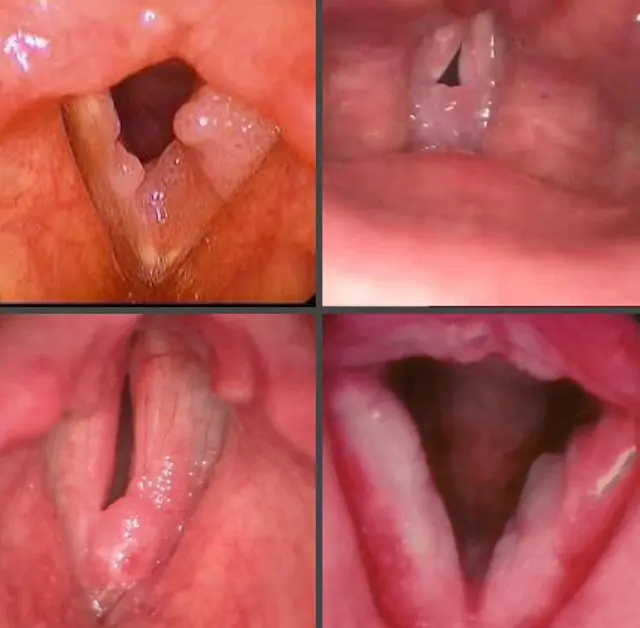
- Reasons for appearance
- What do papillomas on the vocal cords look like?
- Removal methods
Papilloma on the vocal cords is a warty formation caused by the active activity of the virus of the same name. It is located in the middle part of the larynx, closer to the entrance to the trachea. That is why, first of all, you should contact an otolaryngologist. Such a growth can be located both on one fold and on another.
Causes of papilloma on the vocal cords

Papilloma on the vocal cords appears due to the progression of the virus of the same name, which triggers the process of its formation as a result of damage to healthy cells. HPV itself is transmitted through direct contact with an infected person - during sexual intercourse, kissing, or using things shared with him.
Here's what contributes to the formation of papilloma on the vocal cords:
- Wounds in the mouth. If the integrity of the mucous membrane is damaged, the virus can easily penetrate inside with the saliva or blood of an infected person, for example, during a kiss. First of all, it will settle on the oral mucosa, including the vocal cords. If you do nothing about it for a long time, HPV will begin to destroy cells and provoke the formation of papilloma on the vocal cords.
- Habit of biting nails. Under them, many bacteria, infections, viruses, including HPV, accumulate. If you bite unwashed nails, they can penetrate the body and lead to damage to the walls of the oral cavity, which also contains the vocal cords. If the immune system is not strong enough to prevent this, the process will be difficult to stop.
- Failure to comply with personal hygiene rules. This applies to those who rarely or incorrectly brush their teeth, using, in particular, inexpensive toothpastes. People who ignore antibacterial mouth rinses are also at risk for developing papilloma on the vocal cords. Thanks to them, the activity of pathogenic microorganisms is suppressed and the formation of growth here is prevented.
- Treatment at the dentist. Infection with the papilloma virus and the appearance of growths here is possible if the doctor uses insufficiently sterilized instruments. If there are traces of HPV on them, which, for example, can remain along with blood or lymph fluid, it is quite capable of quickly infiltrating the cells of the oral mucosa. This provokes the appearance of papilloma on the vocal cords.
- Oral sexual contacts. This becomes relevant if a woman practices fellatio without using contraception. The likelihood of infection increases if a woman has a violation of the integrity of the mucous membrane in her mouth, and a man also has papillomas on the penis.
- Sharing utensils with the patient. By eating from plates and mugs that have traces of the virus on them, as well as using pots, forks, spoons and other kitchen utensils of an infected person, the virus will penetrate into a healthy body with almost 100% probability. But the fact that he will develop papilloma on the vocal cords can only be discussed if the dishes are not treated with special detergents.
Those who are also susceptible to infection with the papilloma virus who often visits baths, saunas, swimming pools, since it can exist here for a long time. This entails operations that involve cutting tissue, blood transfusions, and examination of the oral cavity by an ENT specialist using poorly sterilized instruments. Infection often occurs during the birth of a child, from an infected mother, or when the baby leaves the uterus.
Penetration of the papilloma virus inside does not mean 100% appearance of a formation on the vocal cords. To do this, the immune system must be very weak and unable to repel HPV attacks, as well as suppress its activity. This is due to poor ecology in the place of residence, constant stress and chronic lack of sleep, long-term and uncontrolled treatment with antibiotics, various gastrointestinal diseases (gastritis, colitis, stomach and intestinal ulcers).
Important! The risk of papilloma on the vocal cords is especially high for those who already have them in the oral cavity - on the palatine or lingual tonsils, tongue, cheek, etc.- See also the causes of papillomas in the throat
What do papillomas on the vocal cords look like?

Photo of papillomas on the vocal cords
In the photo, the papilloma on the vocal cords looks like a small node located at the border of the transition of the larynx to the trachea. The lump measures from 0.5 to 2 cm; the higher this figure, the greater the discomfort in a person. It manifests itself especially acutely during swallowing saliva and eatingwhen it passes into the esophagus with difficulty.
One of the main symptoms of papilloma on the vocal cords is sensation of a foreign body in the mouth, which can bother both one side and the entire surface of the neck.
In the case of active growth and reaching large sizes, almost complete blockage of the lumen of the respiratory tract becomes possible, which manifests itself in asphyxia.
Here are other symptoms of papilloma appearing on the vocal cords:
- Voice change. Often it becomes hoarse, hoarse, as if “smoked.” From the outside it may seem that a person just has a cold, but the situation usually does not change after a course of treatment. The reason for this is pressure on the muscles that are responsible for the sound of the voice. In rare cases, such problems can result in aphonia, which means complete loss of voice.
- Sore throat. This symptom of papilloma on the vocal cords can occur either without any external influence or as a result of physical irritation of the mucous membrane of the throat and the vocal cords themselves. This often occurs when the surface of the papilloma comes into contact with hot or too cold food, spicy and very salty foods, as well as fried foods.
- Coughing. It is provoked by irritation of the mucous membrane as a result of the papilloma coming into contact with it. In this case, soreness in the mouth often occurs, which provokes a cough. At the same time, there are no complaints of sore throat, which complicates the detection of the disease by doctors.
- Low immunity. This is one of the main symptoms of papilloma on the vocal cords, manifested in the form of weakness, dizziness, nausea, tingling in the arms and legs, drowsiness, absent-mindedness, increased anxiety and irritability.
Sometimes a papilloma is mistaken for a benign polyp. Therefore, to diagnose papilloma on the vocal cords, you first need examination of the vocal cords, including using a special otolaryngological mirror. This is usually sufficient for a detailed visual examination and assessment of the state of education.
To exclude its malignancy, which must be done before removing the growth, it is necessary to histology of the sample taken. This will require video endoscopy or laryngoscopy, which may require general anesthesia.
Before treatment for vocal cord papilloma it may be useful CT scan, which clearly shows the location of the papilloma, its boundaries and structure. An alternative to this option is MRI.
It will also be necessary to carry out Digene test (amplification), which allows you to identify the type, degree of oncogenicity and concentration of HPV in the body. This is necessary to prescribe the most effective antiviral drugs.
- See also signs of papillomas on the tongue in the throat
Methods for removing papilloma on the vocal cords

The most common way to remove papilloma on the vocal cords is surgical excision of the formation. Moreover, it is carried out in a relatively minimally invasive way, using micro-instruments. Everything that happens during the operation is displayed on the screen, which allows the doctor to accurately assess his actions and eliminate papilloma without harm to health.
Microsurgical operations are safe, almost never cause side effects or complications, and do not require such a long recovery as after conventional removal of papilloma with a scalpel. But the most important thing here is that they do not injure the vocal cords and thereby do not disrupt the functioning of the speech apparatus.
The only disadvantage of surgical intervention to remove papilloma on the vocal cords is that after it there is a possibility of recurrence of the formation. This is due to the presence of traces of the virus in the epithelial layer of tissue, which can trigger the appearance of new growths. In this case, to eliminate such problems, the patient is prescribed effective anti-inflammatory drugs such as Lykopid, Tsitovir-3, Kagocel.
Here are some more ways to remove papilloma on the vocal cords:
- Endolaryngeal excision. For this, special Moritz-Schmidt forceps are used, with which the lump is carefully pinched off and sent for biopsy. All this is done within a few minutes, but the operation must be performed under local anesthesia. It involves applying anesthetic lotions, gels and other similar products to the treated surface. After such removal of the papilloma, no scars are formed on the vocal cords and no scars remain. The disadvantage of this method is that if the operation is carried out incorrectly, there is a risk of changing the timbre of the voice. The price of endolaryngeal excision is 6900 rubles (3200 UAH).
- Plasma coagulation. Thanks to this method, the papilloma on the vocal cords literally evaporates under the influence of plasma. The latter is formed as a result of the passage of electric current in argon. Since this is a non-contact method of eliminating growth, the procedure does not cause bleeding and does not leave a burn; healthy tissue around the formation is not damaged as a result of it. To completely remove papilloma on the vocal cords, 1-3 sessions may be required, each of which lasts on average 20-30 minutes. The price of plasma coagulation is 2900 rubles (1300 UAH).
- Cryodestruction. When choosing this technique, the papilloma will be destroyed using cold. For this purpose, doctors use liquid nitrogen, which changes the structure of the formation cells and promotes its removal. This is a minimally invasive technique for removing growth that does not require anesthesia, and only in rare cases may topical anesthesia be necessary. For this, one visit to the doctor is usually enough. The procedure lasts about 30 minutes. The price of cryodestruction is 360 rubles (150 hryvnia).
- Electrical destruction. In this case, the papilloma on the vocal cords is removed using a current of a certain frequency. Special electrodes are applied to the growth and held there for several minutes. With their help, it is possible to cauterize the formation and weaken its root. After this, a histological examination is carried out to exclude the process of malignancy. Complete removal of papilloma may require 1-3 sessions, with an average duration of 20 minutes. The price of electrocoagulation is 590 rubles (250 hryvnia).
- Laser removal. This is the most optimal way to remove papilloma on the vocal cords after endolaryngeal excision. It allows you to make an incision without bleeding and remove the growth without injuring the surrounding areas of the mucosa. Thanks to this, it is possible to avoid the formation of scars. This is a minimally invasive technique that is used both in hospital and outpatient settings. The operation is performed within 20-40 minutes. The price of laser therapy is 2900 rubles (1300 hryvnia).
How to get rid of papilloma on the vocal cords - watch the video:
Papilloma on the vocal cords is a very common occurrence, and since it has the possibility of degeneration from benign to malignant, its appearance must be responded to immediately. You must immediately consult a doctor to undergo a detailed examination and, upon receiving approval, remove the growth using available methods.
- Related article: Visiting an otolaryngologist for oral papilloma



